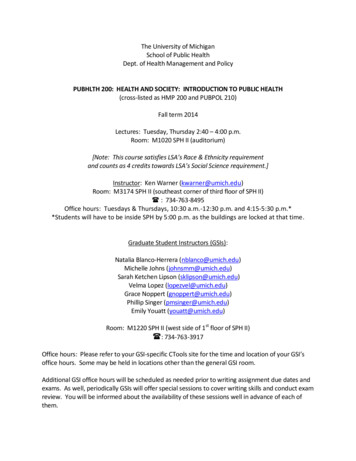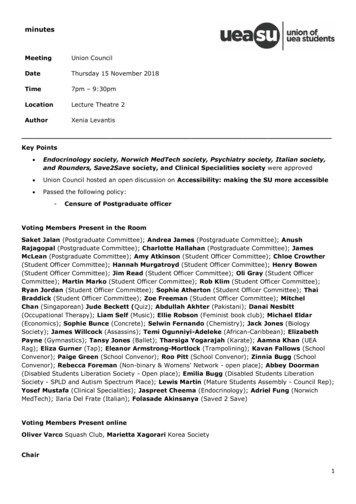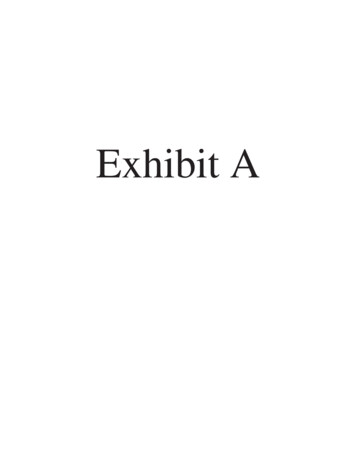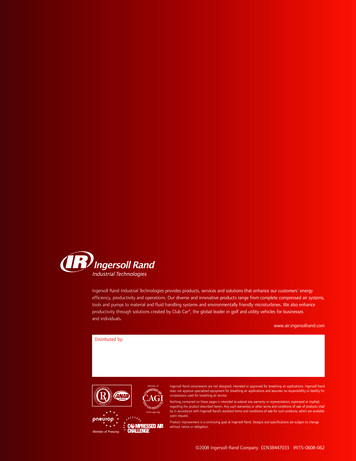
Transcription
The University of MichiganSchool of Public HealthDept. of Health Management and PolicyPUBHLTH 200: HEALTH AND SOCIETY: INTRODUCTION TO PUBLIC HEALTH(cross-listed as HMP 200 and PUBPOL 210)Fall term 2014Lectures: Tuesday, Thursday 2:40 – 4:00 p.m.Room: M1020 SPH II (auditorium)[Note: This course satisfies LSA’s Race & Ethnicity requirementand counts as 4 credits towards LSA’s Social Science requirement.]Instructor: Ken Warner (kwarner@umich.edu)Room: M3174 SPH II (southeast corner of third floor of SPH II) : 734-763-8495Office hours: Tuesdays & Thursdays, 10:30 a.m.-12:30 p.m. and 4:15-5:30 p.m.**Students will have to be inside SPH by 5:00 p.m. as the buildings are locked at that time.Graduate Student Instructors (GSIs):Natalia Blanco-Herrera (nblanco@umich.edu)Michelle Johns (johnsmm@umich.edu)Sarah Ketchen Lipson (sklipson@umich.edu)Velma Lopez (lopezvel@umich.edu)Grace Noppert (gnoppert@umich.edu)Phillip Singer (pmsinger@umich.edu)Emily Youatt (youatt@umich.edu)Room: M1220 SPH II (west side of 1st floor of SPH II) : 734-763-3917Office hours: Please refer to your GSI-specific CTools site for the time and location of your GSI’soffice hours. Some may be held in locations other than the general GSI room.Additional GSI office hours will be scheduled as needed prior to writing assignment due dates andexams. As well, periodically GSIs will offer special sessions to cover writing skills and conduct examreview. You will be informed about the availability of these sessions well in advance of each ofthem.
PUBHLTH 200 – p. 2Introduction and course objectivesThis course is intended to serve as an introduction to the major issues of public health with a focuson the United States, although global health issues are considered as well. We will examine whatthose issues are, what determines them, and how they can be altered. As a survey of the entirefield of public health, the course provides a broad overview for students wishing no more than anintroduction to the field, as well as good grounding for students who wish to pursue additionalcoursework in public health.The specific course objectives are expressed within the following competencies:1. Students will be able to explain what public health is, what distinguishes it from the otherhealth sciences, and what unique contributions it has to make to the health of the public.2. Students will be able to identify the principal determinants of health and disease, as well asthe principal determinants of, and explanations for, inequalities in the health of groupsdifferentiated by race, ethnicity, and socioeconomic status.3. Students will understand when (and why) governments should intervene in matterspertaining to the health of the public and when (and why) they should not. They will beable to describe the major formal organizational structures within the United Statesresponsible for monitoring and improving the public's health.4. Students will be able to describe the basic approaches and purposes of the two majoranalytical methods of public health, epidemiology and biostatistics, without achievingmastery of the methods (i.e., this is not a methods course; that is the subject of othercourses).5. Students will be able to explain the biomedical basis of infectious and chronic diseases andcongenital abnormalities, again without developing detailed expertise on these subjects.6. Students will be able to identify the principal social and behavioral determinants of healthand demonstrate how they influence the most important behavior-related healthproblems of the day.7. Students will be able to identify the principal environmental determinants of health anddescribe the major environmental health issues of the present time.8. Students will be able to explain the role of public health in medical care and identify theprincipal problems in the U.S. health care system. As well, students will become familiar
PUBHLTH 200 – p. 3with the features of and arguments about the Affordable Care Act (also known as“Obamacare”).9. Students will be able to itemize critical issues in global health, with a special focus onhealth in poor countries.10. Students will be able to describe important future issues in public health and explain theirorigins.Classroom procedures (lectures and discussion sections)There are two lectures per week, Tuesday and Thursday, 2:40-4:00 pm. Students are stronglyencouraged to ask questions or otherwise engage the instructor and guest lecturers to clarify oraugment material under consideration. You will be expected to have read daily assigned readingsprior to class. Below, beginning on page 11, you will find a “Schedule of Lecture Topics andAssignments.” For those who must miss a lecture, lectures will be audio recorded and posted onthe course website. We strongly recommend that you attend all lectures if possible as recordingquality will be variable and, for a variety of reasons, an audio recording cannot replace thecomplete experience of attending lectures.Each student will also participate in a weekly one-hour discussion section. Attendance is requiredfor discussion sections. Missing section meetings will affect a student’s discussion section grade,which counts 20% of the course grade. (See “Assignments, exams, and course grading” below.)Discussion section topics will vary from week to week, ranging from further discussion of materialspresented in lecture to consideration of public health topics complementing those examined butnot covered extensively in lecture. See the “Schedule of Discussion Section Topics andAssignments” beginning on page 17.Policy on laptops, iPads, phones, and other electronic technology in lectures: Use of all suchelectronic devices will not be permitted during lecture. While I regret the inconvenience forstudents who like to use laptops for note-taking, the frequent other uses during class time –checking email, texting friends, surfing the Web, working on other course assignments – createdistractions for both users and their neighbors alike and are disrespectful to one’s fellow studentsand to the instructor. As well, research indicates that students learn better without having suchtechnology in use at the time of lectures. Use of electronic devices during discussion section willbe at the discretion of your individual GSI.
PUBHLTH 200 – p. 4Use of CTools websites PUBHLTH 200’s main CTools website will be used to post the course syllabus, readings (other thanthe Schneider textbook), assigned videos, announcements (also distributed as emails), andPowerPoint lecture slides (more under “Required reading and lecture slides,” immediately below);provide a course calendar; distribute writing assignments; and provide occasional information onnewsworthy items. For scheduled items (e.g., writing assignments), students will be expected toconsult the site according to the schedule in the syllabus (and on the calendar on the site). Forunscheduled postings, the class will be informed by email. Each GSI will have his/her ownCTools site for his/her sections. Students will use their GSI’s site to submit their writingassignments (see “Assignments, exams, and course grading” below). GSIs will use their sites topost announcements relevant only to their sections’ students.Required reading and lecture slides Most assigned readings are in a textbook by Mary-Jane Schneider, Introduction to Public Health,4th edition (Jones and Barlett, 2014), which all students should purchase. We will read the book inits entirety except for one chapter. Additional readings and assigned videos, indicated on thecourse schedules below, will be posted on the website under Resources (folder labeled AdditionalReading Materials and Videos for Lectures) or Assigned Videos section.We will be using PowerPoint slides for lectures. The instructor will post these on the coursewebsite for you to review as you see fit, also under Resources. Many of you may wish to print offhardcopies in advance of class for purposes of taking notes directly on the slides. I will make asincere effort to post the slides no later (generally much earlier) than 5 p.m. on Monday forTuesday lectures and 5 p.m. on Wednesday for Thursday lectures.Three comments on the readings will assist you in maximizing your learning experience in thiscourse. First, as noted above, readings should be completed prior to the class or discussion sectionin which the relevant material will be covered. In preparing lectures and discussion, we willassume that you have already read the assigned pages. (“Readings” include the assigned videos.)Second, some of the material in the readings will not be covered in lecture. Such material isintended to supplement what is covered in class. Anything included in the assigned readings isfair game for exams, whether or not it is discussed in class (but see the third comment,immediately following).
PUBHLTH 200 – p. 5Third, and finally, some readings go into a great deal of detail (e.g., a listing of all the chemicalcompounds covered by governmental drinking water standards). The objective is for students togain a good general understanding of the phenomena of interest, not to require students tomemorize the details. All of your reading should be focused on learning basic relationships,principles, and major concepts and how they are applied. This does not mean that you will not beexpected to recall some specific facts, but when such is requested of you, the facts will relate tocritical aspects of our consideration of public health. For example, I consider it pretty “basic” thatyou know that two-thirds of American adults are overweight or obese. This is one of those veryimportant facts that everyone interested in public health should know. Another such fact is thatU.S. health expenditures account for 18% of the nation’s gross domestic product, dramaticallymore than any other country in the world.Assignments, exams, and course gradingCourse grades will be based on two exams, each covering half of the course, two writingassignments, one graded presentation in your discussion section, and an overall grade for yourparticipation in your section, as follows:1. Each of the two exams (midterm on October 21st and final on December 12th) will count25% of the course grade. The final will cover only material presented after the midterm.2. Each of the two writing assignments, essays of no more than 5 pages each, will count 10%.3. In a team of approximately 4 students, assigned by your GSI, you will prepare a PowerPointpresentation on an environmental health case study and, with your teammates, present itin your section. The group’s presentation will be graded, and your individual grade will bedetermined by the group grade and your teammates’ assessment of your contribution tothe presentation. (This will be explained at the time of the assignment.) This will count10% of the course grade.4. Participation in your discussion section will count 20% of the course grade. Your discussionsection grade, determined by your GSI, will be based on the following two factors, eachelaborated upon immediately following this paragraph: (a) your active participation indiscussions; and (b) the regularity of your section attendance.a. Active participation in discussions: Students are encouraged to participate activelyin discussion section. Your GSI will evaluate your participation based on both itsquantity and quality and will give you feedback on your performance in this regardno later than midway through the course. Recognizing that some students may
PUBHLTH 200 – p. 6feel uncomfortable making oral contributions, we will not give a grade of less thanB for the discussion section grade to anyone who attends all of the sessions (exceptfor one unexcused absence). Note, however, that we very much hope thateveryone will feel comfortable contributing to discussions. The ability to interacteffectively with one’s colleagues is a vital element in success in nearly allprofessions. College is a great place to learn the relevant skills and to gainexperience exercising them. We will expect all students, and all GSIs, to berespectful of each other’s contributions, whether we agree with them or not.b. Regularity of attendance: Students will be expected to attend all scheduleddiscussion section meetings, with one unexcused absence permitted. For the firstunexcused absence beyond that one (i.e., the second unexcused absence),students will be docked one grade for their overall discussion section grade. Thismeans that if a student’s participation in discussion section otherwise warranted anA-, that student’s section grade would be lowered to a B . If a third unexcusedabsence occurs, students will be docked three additional grades for their overalldiscussion section grade (in the example, to a C ). A fourth unexcused absence willresult in a grade of F for the discussion section portion of the course grade.Tardiness of more than 10 minutes from the scheduled discussion section starttime will be counted as missing that section altogether. If you must miss adiscussion section due to illness, a family emergency, a religious holiday, or someother valid reason, please get permission from your GSI prior to the class inquestion.Four grade-related observations should be emphasized:1. Each of the two major writing assignments must be typed double-spaced in an 11- or 12point font with margins of one inch (or slightly larger). Each of the two writing assignmentsmust not exceed 5 pages (not including bibliographic references). A paper that exceedsthis page limit – by running over 5 pages or using a smaller font or failing to have adequatemargins (or some combination) – will lose one grade, as above. Thus, for example, anotherwise A paper that runs 5.5 pages will be reduced to an A-. The reasons for this strictrequirement are two-fold: The first is to help you learn to follow precise directions,including learning how to edit your essays to fit required limits. (Such limits pervadeprofessional practice. For example, if faculty members submit a grant application tocertain grant-giving agencies and their description of the grant’s purposes and methodsexceeds the agency’s page limits, their application will be returned unread.) The second
PUBHLTH 200 – p. 7reason for this strict requirement regarding the length of papers is to ensure that thegrading burden for the GSIs will not be unrestrained.2. Failure to submit these writing assignments by noon on their due date (without explicitpermission from the instructor or your GSI for truly extenuating circumstances) will resultin a grading penalty. Papers submitted up to one day late will be penalized one full lettergrade. Thus, a paper that otherwise deserves an A- will receive a B-. Papers submittedmore than one day but no more than 2 days late will lose two full letter grades (so theotherwise A- paper would be graded C-). No paper will be accepted more than 2 days late.3. As noted above, the second (final) exam is scheduled for December 12th (from 4:00-5:30pm). It is against University policy to make individual arrangements to take the examearlier, and would be especially difficult to do so for a course this size. Therefore, allstudents must take the exam on December 12th at the scheduled time. There will be noexceptions. Please plan your holiday travel accordingly. (The same holds for the midtermexam, scheduled October 21st during class time.)4. For each paper, your group presentation, and discussion section participation, you willreceive a letter grade ranging from A to F. When we calculate course grades, we’ll use a4-point scale, with A worth 4.0 points, B 3.0 points, C 2.0 points, and D 1.0 point. For a“plus”, add 0.33 points to the letter grade (e.g., a B is worth 3.0 points for a B plus 0.33 forthe “ ”, for a value of 3.33). For a minus, subtract 0.33 from the letter grade (e.g., an A- isworth 4.0 points for an A minus 0.33 for the “-“, for a value of 3.67 points).For the two exams, you will receive a score indicating the percentage of the availablepoints you got right. If, for example, the exam’s component parts add up to 67 points andyou get 53, you will see a score of 79%. Exam grades will be curved on the basis of theclass distribution of percentage scores, with the grades then converted to the A 4.0 scale.You can expect the mean grade on the exams to be a high B . (The exam scores will beconverted precisely from the percentage score to the grade-point score. An example:Suppose that 83% corresponds to the exact middle of the B range and 88% is the exactmiddle of the A- range. Then a score of 83% will receive the average B score of 3.33 andthe 88% will receive the average A- score of 3.67. If your exam score is 85% – 2/5th of theway between 83% and 88% – you will receive a score of 3.466 – exactly 2/5th of the waybetween 3.33 and 3.67.)Ultimately, all the components of your course grade will have a point value based on the A 4.0 scale. If your course grade is 3.50 (exactly midway between a B and an A-) to just
PUBHLTH 200 – p. 8under 3.835 (midway between an A- and an A), you’ll receive a course grade of A-. And soon.Statement on Student Health and Well-beingThe PUBHLTH 200 teaching staff believes it is important to support the physical and emotionalwell‐being of our students. If you are experiencing physical or mental health issues, weencourage you to use the resources on campus such as those listed below. If you have a healthissue that is affecting your performance or participation in the course, and/or if you need helpconnecting with these resources, please contact the instructor or any of the GSIs. Counseling and Psychological Services (CAPS), www.umich.edu/ caps, 734‐764‐8312Services for Students with Disabilities (SSWD), www.umich.edu/ sswd, 734‐763‐3000University Health Services (UHS), www.uhs.umich.edu, 734‐764‐8325Sexual Assault Prevention & Awareness Center (SAPAC), www.umich.edu/ sapac/, 734998-9368If your situation is not life threatening but you have an urgent question that cannot wait forUHS to open, you may call the after‐hours nurse at 734‐662‐5674. If you find yourself in anemergency situation, please call 911 or go to the UM Hospital Emergency Room.Students with special circumstancesIf you need special accommodations due to a disability or illness, please inform your GSI as soon aspossible. In particular, if you are registered with the UM’s Services for Students with Disabilitiesand will need accommodations, please provide your GSI with the relevant form within the firstthree weeks of class.Academic conduct: expectations and penalties for failure to comply“I like the writing in the paper. I onlywish more of it had been yours.”Considerable national attention has been focused on the issue of cheating by students at all levelsof education. Although we hope that the phenomenon is rare at the University of Michigan,episodes occur every year. Cheating and other forms of academic misconduct will not betolerated in this course. Similarly, courtesy, honesty, and respect should be shown by students
PUBHLTH 200 – p. 9toward fellow students, faculty, visitors to the course, and administrative support staff. As well,students should expect the instructor and the GSIs to treat them fairly; exhibit respect for theirideas and opinions; and strive to assist them in maximizing the value of their experience in thiscourse and, more generally, in their education.Student academic misconduct refers to behavior that includes plagiarism, cheating on exams orassignments, fabrication of data, falsification of records or official documents, intentional misuseof equipment or materials (including library materials), or aiding and abetting the perpetration ofsuch acts. Preparation of papers, assigned on an individual basis, must represent each student’sown individual effort. When used, resource materials should be cited in conventional referenceformat.Detected violations of proper academic conduct will be dealt with firmly. Any form of cheating onan assignment or an exam will result in the student’s failing that assignment, with no opportunityto make up the work. If a student is determined to have violated proper academic conduct twiceduring the course, he or she will fail the course and the behavior will be reported to the Dean ofthe student’s school or college.Religious holidaysSome religious holidays may occur on regularly scheduled class days. Because available classsessions are so limited in number, we will have to hold class on all such days. Students who willnot be in class on these days should listen to the lecture posted on the course website and, ifpossible, make arrangements with classmates to share class notes with them. In the case ofdiscussion section meetings, students should receive permission from their GSIs in advance to missa section meeting due to religious reasons.Sharing information regarding events and organizations – The Friday DigestMany students in this class are members of organizations that do important public health-relatedwork, here on campus, nationally, or internationally. Often these students want to inform theirclassmates about the organizations or their events, and often they ask the instructor or GSIs fortime at the beginning of lecture or discussion section to describe the organizations or events.Frequently we receive similar requests from organizations that do not currently include PUBHLTH200 students among their members.We simply do not have the class time to accommodate the many such requests we receive.Instead, every Friday we post announcements on the course website under “Friday Digest.” The
PUBHLTH 200 – p. 10Digest includes information about organizations, events, contemporary news stories of interest,etc. If there is something you would like included in the Friday Digest, please contact your GSI withthe information in as concise a form as possible (with links to URLs a good way to provide moredetail). If received by Thursday morning, we will include your notice in that week’s Friday Digest.If received too late for inclusion that week, it will be included the following week. (The FridayDigest will not be distributed if there is nothing important to share that week.)A requestI genuinely want to make this course the best educational experience it can be, for future years'students as well as for you. As such, I seek your feedback on either course content or procedure.If your suggestions are to benefit current students, concerns will have to be communicated in atimely manner. Feedback after the course is completed will be appreciated too. I am receptive toand grateful for all suggestions. While I will not necessarily adopt every suggestion, I have a longhistory of modifying course offerings in direct response to students’ recommendations. A greatexample is the existence of discussion sections in this class (and the associated conversion of thecourse from 3 to 4 credits), changes that were made in direct response to feedback from studentsin the course’s first year. If you are comfortable doing so, please communicate your concerns indirect conversation with me or with your GSI (in person, by email, or over the phone). If you havecriticisms you prefer to deliver anonymously, please leave an unsigned note with my assistant, GailPieknik, in her office (M3541 SPH II, adjacent to my office); or leave a note in my faculty mailbox inthe Department of Health Management and Policy mailroom, M3148. Thank you.
PUBHLTH 200 – p. 11Schedule of Lecture Topics and Assignments(Exams and writing assignments are highlighted in red)DateTopicAssignmentsSept. 2Introduction and overviewHealth and public health:Basic facts and conceptsSept. 4Health and health inequalities in the U.S.Sept. 9What is “public health”?Sept. 11History of public health in the U.S.Sept. 16Role of government in healthHealth, United States, 2012, At aGlance and Highlights, pp. 1-6.Browse other material of interest.*[See important note at end ofSchedule of Lecture Topics andAssignments.]Video: “Unnatural Causes: IsInequality Making Us Sick?” Episode 1:“In Sickness and in Wealth”Text prologue and chaps. 1-2McKenzie et al., “A Brief History ofCommunity and Public Health,” pp.11-20 (plus table p. 21), in AnIntroduction to Community Health, 6thed. (Jones and Bartlett, 2008)Text chap. 3Gostin, “Public Health Law in a NewCentury. Part III: Public HealthRegulation: A Systematic Evaluation,”JAMA 2000, v. 283, pp. 3118-3122Writing assign. #1 distributedThe core science of public healthSept. 18EpidemiologyGuest lecturer: Dr. Sharon KardiaText chaps. 4-6
PUBHLTH 200 – p. 12Sept. 23Data and biostatisticsGuest lecturer: Dr. Bhramar MukherjeeText chaps. 7-8Biomedical basis of health and diseaseSept. 25Sept. 30Chronic disease, congenital diseaseGuest lecturer: Dr. Sharon KardiaInfectious diseaseGuest lecturer: Dr. Marisa EisenbergText chaps. 11-12Beaglehole et al., “Priority Actions forthe Non-communicable DiseaseCrisis,” Lancet 2011;377:1438–1447Text chaps. 9-10Writing assignment #1 due by noonTODAYSocial and behavioraldeterminants of healthOct.2Health behavior: half of the problemText chaps. 13-14Oct.7Tobacco: public health enemy #1Text chap. 15Warner and Mendez, “TobaccoControl Policy in Developed Countries:Yesterday, Today, and Tomorrow,”Nicotine & Tobacco Research 2010, v.12, pp. 876-887.Oct. 9Oct. 14Oct. 16Diet, nutrition, physical inactivity, andobesityFall study break – No classInjury: Killer of young and oldOct. 21Midterm examEnvironmental health grouppresentation assignment distributed.The assignment will be discussed insection meetings this week. Thegroup presentations will occur insection the weeks of Nov. 4th andNov. 11th.Text chap. 16Text chap. 17
PUBHLTH 200 – p. 13MCH and Mental HealthOct. 23Maternal and child healthGuest lecturer: Dr. Matt DavisText chap. 18Lu and Johnson, “Toward a NationalStrategy on Infant Mortality,”American Journal of Public Health,2014, v. 104, supplement 1, pp. S13S16.Oct. 28Oct. 30Mental healthGuest lecturer: Dr. Gregory DalackHealth disparities among LGBTpopulationsGuest lecturer: Dr. Jose BauermeisterOptional: Rossen and Schoendorf,“Trends in Racial and EthnicDisparities in Infant Mortality Rates inthe United States, 1989-2006,”American Journal of Public Health,2014, v. 104, pp. 1549-1556.Text chap. 19Johns et al., “Sexual Attraction, SexualIdentity, and Psychological Well-Beingin a National Sample of Young WomenDuring Emerging Adulthood,” Journalof Youth Adolescence 2013, v. 42, pp.82-95.Coker et al., “The Health and HealthCare of Lesbian, Gay, and BisexualAdolescents,” Annual Review of PublicHealth 2010, v. 31, pp. 457-477Environment and healthNov. 4Nov. 6Nov. 11Environmental health (1)Guest lecturers: Dr. Richard NeitzelEnvironmental health (2)Guest lecturers: Dr. Richard NeitzelSafe food and drugsText chaps. 20-21Text chaps. 22-23Text chap. 24Tucker, “New Law Will Empower FDAto Improve Safety of U.S. Food,”Nation’s Health, Feb. 2011, pp. 1, 10.
PUBHLTH 200 – p. 14Nov. 13Population growth and populationplanningWriting assign. #2 distributedText chap. 25The medical care systemand public healthNov. 18Medical care and public healthGuest lecturer: Dr. Richard LichtensteinText chaps. 26-27Video: Green, “Why Are Health CareCosts So High?” video available at [Donot miss this highly informative – andhighly entertaining – video. It issuperb introductory coverage of itstopic.]Nov. 20The Affordable Care Act (Obamacare) andpublic healthGuest lecturer: Dr. Richard LichtensteinOptional: Reid, The Healing ofAmerica: A Global Quest for Better,Cheaper, and Fairer Health Care (NewYork: Penguin Books, 2010). [Thisshort and very readable book gives aterrific overview of how differentcountries handle health care, and howthe American (non)systemincorporates all of the models of carefinance and delivery. Highlyrecommended.]Connors & Gostin, “Health CareReform: A Historic Moment in U.S.Social Policy,” JAMA 2010, v. 303, pp.2521-2522Nussbaum, “Obamacare Unveiled asCalifornia, New York LeadU.S.”, Bloomberg News, May 28, 2013.Optional/recommended: KaiserFamily Foundation, “Focus on HealthReform: Summary of New HealthReform Law,” pub. #8061,
PUBHLTH 200 – p. 15Looking toward the futureNov. 25Emergency preparednessText chap. 30Writing assignment #2 due by noonTODAYNov. 27Dec. 2Dec. 4Dec. 9Thanksgiving – No classAging and public healthGlobal healthThinking about the futureText chap. 29Tilchinsky and Varavikova, “GlobalHealth,” chapter 16 in The New PublicHealth, 2nd ed. (Elsevier, 2008) [Pages621-634 are optional but only due tothe “density” of the chapter. You arestrongly encouraged to read them.]Optional: The Global Burden ofDisease Study 2010, The Lancet, vol.380 (Dec. 15, 2012 – Jan. 4, 2013), pp.2053-2260. [This is an invaluableresource for anyone truly interested inglobal health. All of the papers areavailable free of charge, although youwill be asked to register.]Text chap. 31Frieden, “A Framework for PublicHealth Action: The Health ImpactPyramid,” American Journal of PublicHealth 2010, v. 100, pp. 590-595Review Beaglehole et al., “PriorityActions for the Non-communicableDisease Crisis,” Lancet2011;377:1438–1447 [originallyassigned for Sept. 25]Dec. 12,4:00-5:30p.m.Final examNo assignment(Who’s he kidding?!)
PUBHLTH 200 – p. 16* Reading assignment for Sept. 4: This assignment is accessible on the course Website under Resources,in the folder labeled Additional Reading Materials and Videos for Lectures, or you can link directly to theentire report at http://www.cdc.gov/nchs/data/hus/hus12.pdf. This annual report is an invaluableresource, absolutely loaded with useful statistics, several of which we will review in class. Read the briefassigned summary with an interest in general trends, rather than details. I encourage you to browseother than the few assigned pages to learn more about issues of specific interest to you. You can linkdirectly to figures or tables of interest through
health sciences, and what unique contributions it has to make to the health of the public. 2. Students will be able to identify the principal determinants of health and disease, as well as the principal determinants of, and explanations for, inequalities in the health of groups differ










